

CHRISTIAN LEADER

10
Foot washing
15 Marriage mix-ups
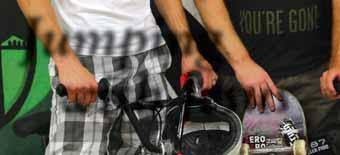




10
Foot washing
15 Marriage mix-ups

26
Caregiving emotions



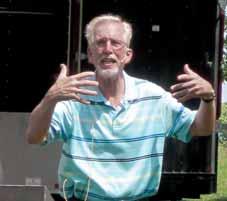
As I write this, our congregation at Ebenfeld MB Church is preparing to celebrate the retirement of Pastor Gaylord Goertzen, pictured left. Pastor Gaylord served the Mennonite Brethren church in Balko, Okla., for nine years and then our congregation in rural Hillsboro, Kan., for 25 years. He is the only pastor that my children have known, a rare opportunity for young people in their late teens and early 20s.
So how does a congregation say thank you to a pastor and his family for decades of hard work, sacrificial dedication and multiple blessings? There is the usual list of retirement activities—a dinner, appropriate gifts and words of thanks and appreciation. All good things—and we’re planning a Celebration Sunday honoring Gaylord and his wife, Peggy, which will include them all.
But there is one gift that our congregation can give Gaylord that will keep on giving. It’s the same present that you can give your pastor: your commitment to making discipleship a priority and to doing so within a community of faith.
Your pastors need encouragement just like everyone else. But also encourage your pastors by taking seriously the ways in which they are leading you....

Connie Faber Editor
A church is only as strong as the disciples within, says writer and pastor Elizabeth Evans Hagan. In her essay, “Re-thinking Pastor Appreciation Month,” Hagan lists three things that typify devoted disciples.
• Disciples attend church regularly—even when a relaxing morning at home sounds so refreshing—because they believe that faith is lived out in community.
• Disciples give regularly—even when there are lots of other good things to spend their money on—because they know that everything we have comes from God in the first place.
• Disciples serve—even when they think their gifts aren’t very significant—because they believe that God will bless what they offer.
October is Pastor Appreciation Month, initiated by Focus on the Family in 1994. Noting that pastors and their families live under incredible pressure, the Focus on the Family website encourages congregations to make a difference in the lives of their pastoral leaders: “Clergy Appreciation Month is one way we can counter the negative erosion in the lives of our spiritual leaders with the positive affirmation they need.”
So, do the things you normally do in October for Pastor Appreciation Month—take your pastor(s) out for lunch, give a gift certificate or send a card. Your pastors need encouragement just like everyone else. But also encourage your pastors by taking seriously the ways in which they are leading you individually and corporately to be authentic disciples of Jesus Christ. Come to church ready to worship and to encounter God. Be open to grow in your own faith when attending Bible study or a small group. Find something to do at church and serve with enthusiasm—volunteer to serve on the cleanup crew for the Wednesday night meals, to rock babies in the church nursery or to lead a new ministry. Your congregation will thrive and your pastors will be inspired when you faithfully pursue your call to discipleship.






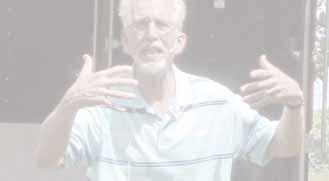










In the early days of my ministry an elderly gentleman taught me to love Psalm 27. Every time I called for a Scripture at our Prayer and Bible Study he offered Psalm 27:1: “The Lord is my light and my salvation, whom shall I fear?”
I don’t recall Marvin ever quoting another Scripture, and while that frustrated me at the time, I now turn to Psalm 27 often. I have memorized it and meditate on it frequently when I lie down, rise up or lay awake during the night.
Well-known columnist Ann Landers learned from thousands of requests for advice that the #1 problem people face is fear.
Google “phobias” and check out “A List From A to Z.” You’ll be amazed at the fears that plague people. If you have a phobia it’s not funny; if you don’t, it may be difficult to understand those who do. There’s even one called phobophobia—the fear of fear!
In Psalm 27 I’m drawn to the “bookends” that frame our hope in God’s goodness. It opens with great thoughts about God (vv. 1-2) and closes with more confidence in God’s willingness to meet us in life’s dilemmas (vv. 13-14). Woven between those ideas are multiple reasons for fear and concern (vv. 3-12).
Amazingly this psalm offers two very different moods. In verses 1-6 David exudes confidence in God’s great care—he felt untouchable and invincible with God by his side. But in vv. 7-14 the tone shifts dramatically as David cries out for God’s help, pleading to not be forsaken. Obviously David faced spiritual battles as well as the physical ones described in 1 and 2 Samuel.
We relate to Psalm 27 because we know those feelings—the ups and downs of walking in this world; the forward and backward steps of walking with God. Sometimes we are hesitant to put words to our fears or express our feelings when God seems more distant. Not the psalmists. They let it all out.
When I shared Psalm 27 with our congregation recently it resonated with many. As we identified our fears, a range of topics immediately surfaced. If we try to name our fears we don’t have far to look. Watch the news, read your email, sit by the phone and wait for a child to call or go to work and face an unreasonable boss. Wherever we turn there is cause for fear.
Psalm 27 offers good news regarding our fears. Certainly there is a time to look for professional help—the source of some fears needs to be identified, prayed through and prayed out. But I am convinced that Psalm 27, and others like it, can lead us to a place where we rise above our fears. It points us to God, our great source of confidence.
Dennis Fast is lead pastor at Reedley (Calif.) MB Church.
“The Lord is my light and my salvation, whom shall I fear?”
October / November 2013 Volume 76 • Number 5
Connie Faber EDITOR
Myra Holmes ASSISTANT EDITOR
Shelley Plett GRAPHIC DESIGNER
Janice Vander Molen COVER PHOTO (l-r) David Askvig, Rob Dean, Josh Jost
See story on page 20
The Christian Leader (ISSN 0009-5149) is a gathering place for the people, passions and mission of U.S Mennonite Brethren. The Christian Leader is published bimonthly by the U.S. Conference of Mennonite Brethren Churches. However, the opinions expressed here are not necessarily those of the church as a whole.
COPYRIGHT The articles printed in the Christian Leader are owned by the CL or by the author and may not be reprinted without permission. Unless noted, Scripture quotations are from the New International Version.
READER PARTICIPATION Letters to the editor should be 300 words or less and on one subject. Letters must be signed and include the writer’s city and state. Letters will be edited for clarity, appropriateness and length. Letters will be published, as space allows, unless marked, “Not for publication.” Readers interested in contributing essays for In My Humble Opinion and First Person should contact the editor. Freelance article submissions are welcome; a SASE must accompany articles.
SUBSCRIPTIONS $10 for six issues and $20 for 12 issues ($15, $30 in Canada; all other countries $25 for six issues); $1.50 per copy
CORRESPONDENCE: All correspondence, including subscription questions and address updates, should be addressed to Christian Leader Box 155, 107 N. Main, Hillsboro, KS 67063-0155 Phone: 620.947.5543
E-mail: christianleader@usmb.org
MEMBERSHIP The Christian Leader is a member of the Evangelical Press Association and Meetinghouse, an association of Mennonite and Brethren in Christ editors.
POSTMASTER Send address changes to Christian Leader, Box 155, Hillsboro, KS 67063. Periodicals postage paid at Hillsboro, Kansas.
The Christian Leader is published by

U.S. Conference of MB Churches

Ed Boschman USMB executive director ebed@usmb.org
“Trust me!” “We are asking you to trust us in this.” “You are going to have to trust the leadership on this.” No doubt you have heard these exhortations before. Sometimes it’s the church leader. Sometimes mom and/or dad. Perhaps your teacher or coach. Or maybe even your spouse.
How do you respond? And how do you feel about how you respond? Ernest Hemingway said, “The best way to find out if you can trust somebody is to trust them.” I’ve got some stories to tell about how that works, and I’m pretty sure you do as well.
A recent AARP Bulletin reported some data on this subject as a result of an “on-the-street” video interview poll. The question was: How much do you trust the following people? The research report categorized the data into two age groups: those 18 to 49 years old and those of us 50-plus. Used car salesmen and corporate chief executive officers (CEOs) received the same ratings: 3 percent from the younger set and 5 percent from the rest of us. Members of Congress are almost in a dead heat with 11 percent and 12 percent. Our president gets the dubious honor of being trusted by 31 percent of those in the first half of life and 34 percent by the rest. The category which pointed out the greatest gap in the age groups was that of neighbors, where 50 percent of the older set express trust and only 27 percent of those under 50 do so.
This got me thinking about the second greatest command. If the godly model of relationships is that we love our neighbors as ourselves and if trust
is a function of honorable personal relationships, we are losing important ground here. Is it because we are so cocooned that we don’t know our neighbors? Is it because we didn’t return the dozen eggs we borrowed? Or because we don’t put away our trash cans? Or because we simply never bother to wave or say hi? Or have we communicated by our lifestyle that they are not welcome at our house and are unworthy of sharing a meal with us or joining us at a party?
The survey goes on to report that “best friends” get the highest level of trust: 79 percent and 81 percent. Looks like we pretty much all agree on this. True friends do, after all, almost always stand by their friends. In many ways, that is why they are friends. Real friends are the kind that love, accept and forgive. It amazes me that Jesus refers to his disciples as friends. Seems to me he believes in us.
One more statistic: Religious leaders receive a trust rating of 49 percent by the younger set and 57 percent by the rest of us. This is a travesty. While I know full well that we spiritual shepherd-types are only human, the fact remains that we will be held to a higher standard and that our trustworthiness is critical to effective faithfulness on our assignment to equip the saints and lead the disciple-making mission assigned to Jesus’ followers.
Oh how I earnestly, humbly and, with some confidence, hope and pray that those who know me are able to give me a grade better than 49 or 57 percent. I’m committed to deserving stellar trust. In fact, that is my prayer for all of us USMB pastor-types. In my humble opinion, it’s part of what it means to be found faithful.
If the godly model of relationships is that we love our neighbors as ourselves and if trust is a function of honorable personal relationships, we are losing important ground here.
While Director Ed Boschman’s article, “Is religion losing its influence?” (Conference Call column in Aug/Sept issue), contained some worthwhile suggestions, it also implied that America is or was a Christian nation. If this came from a layperson, it would be understandable because American Mennonite Brethren have been heavily influenced by fundamentalism and the Religious Right. But I am surprised that an important MB leader appears to have moved in such a direction.
Our founding fathers (with some exceptions) did not embrace the historic Christian faith and thus cannot be regarded as orthodox Christians. Indeed, they minimized or rejected the supernatural aspects of the Christian faith. Rather, they believed religion was an important factor in establishing national values and this religion contained a substantial dose of
Christian principles. But this did not make early American society Christian. In fact by 1790, approximately 90 percent of the population was unchurched. (Today about 40 percent attend a church, synagogue or mosque).
Many Mennonite Brethren, including Mr. Boschman, seem to confuse Christendom and Christianity. Christendom is the notion that Western civilization (including America) is a Christian society and that while the church and state have different roles, they are both united in their adherence to the Christian faith. Christendom, however, is not Christianity and such a view has been rejected by the Anabaptist/Mennonite tradition.
The Christian Leader welcomes letters to the editor. Letters should be 300 words or less and on one subject. Letters must be signed and include writer’s city and state. Letters will be edited for clarity, appropriateness and length. Letters will be published, as space allows, unless marked “not for publication.” Readers wishing to respond to articles published electronically can post comments on our website (www.usmb.org/christian-leader) and can also leave comments on the CL Facebook page. Comments posted on the website and Facebook will not be published in the CL Magazine. Readers who would like their online comments to be printed should forward those remarks to the editor at editor@usmb.org
Some months ago my wife, Susan, and I attended the 60th birthday party for Cynthia Jordan; we call her “CJ.” Instead of receiving gifts fit for a fun-loving 60-year-old— canes, walkers, dentures, etc.,—CJ gave her guests a free meal, presents and an evening filled with praise to God for connecting her to Jesus through our church family. As I listened to her honor the Lord, I recalled her story.
CJ’s sudden presence startled our prayer group one evening six years ago. She was walking down the street to another church further down the block, but the Holy Spirit tugged on her heart to walk in on us. CJ was broken emotionally and spiritually. After the death of her husband in a car accident, she had a nervous breakdown. She lost her job, became estranged from her son, was taken advantage of by her siblings and spiraled into depression.
After moving to Bakersfield she began working in an assisted living facility a block from our church campus. One of our members was leading a Bible study group in the care facility and invited CJ to attend Heritage Bible Church.
That Wednesday night she found some new friends in our prayer group who literally and figuratively put their arms
around CJ. It was only a few days later that she was fired from her job, where she also lived, and escorted to the streets. She had no place to go. One of her coworkers invited her to sleep in his car while he was inside working. People in our church family opened their homes so CJ could begin to heal.
Over the past half-dozen years we have had the privilege of watching CJ become more like Jesus. I watched as the church family supported her through the death of her mother and then the surprising death of her fiancé. Through all of these challenges, CJ has seen God walk with her, and she has come to believe that God has allowed her to go through these trials because he has wanted to use her story as a beacon of hope for those who struggle.
Remembering how God used his church to bring healing and strength to CJ is a testimony of God’s grace worth retelling. CJ also taught me how to have a birthday party that tells God’s story through our lives. May more of our birthday parties be a celebration of what God has done.
Dave Froese is the lead pastor of Heritage Bible Church, Bakersfield, Calif.
In spite of efforts to increase financial support among USMB congregations and generous individuals, the U.S. national conference finished the 2012-13 fiscal year with a deficit of more than $100,000. The fiscal year closed May 31, and results of the year-end audit were announced Aug. 8.
“While we had planned to overspend our budget by about $50,000 … we ended our year with expenses over income in the amount of $103,055,” USMB Executive Director Ed Boshman wrote to USMB church pastors, moderators and treasurers in early August. “We are grateful that we had reserves to cover that shortfall.”
USMB staff members were successful in keeping expenses under budget by about $1,600. Expenses for 2012-13 totaled $939,548, while total income was $836,493.
Staff fundraising was a priority, with an aggressive goal of $394,284, a 97 percent increase over the 2011-12 fiscal year. At year-end, staff fundraising, a goal that was reduced in October to $256,000, totaled $248,484.
Church giving, the largest single source of income for the national conference, was up over the previous year—from $384,937 in 2011-12 to $407,592 in 2012-13. “We are deeply grateful for the strong support given us by our partner churches,” says Boschman. Read more at www.usmb.org/usmb-fundraising-shortfall. — Connie Faber
Terry Brensinger has been appointed dean and vice president of Fresno Pacific Biblical Seminary (FPBS), Fresno, Calif., starting Aug. 1. FPBS is a school of Fresno Pacific University and is the USMB school for graduate-level theological education. Brensinger joined the seminary in 2011 as professor of pastoral ministry. He holds a doctorate in Old Testament, master’s degrees in biblical studies and ancient near Eastern archaeology and a Master of Divinity degree. Before coming to the seminary, he was a faculty member at Messiah College in Mechanicsburg, Pa., pastored churches and taught overseas. Brensinger and his wife, Debra, have three grown children. He succeeds Lynn Jost.—FPU


When delegates and guests of the Southern District Convention (SDC) gathered for their biennial convention Aug. 2-4 in Colorado Springs, Colo., they were challenged to reclaim their Mennonite Brethren heritage. “I am going to try to inspire you to take your communion and tradition seriously,” said keynote speaker Don Davis, pictured far left with Jason Phelps, pastor at Watershed, a SDC church plant. “If there ever was a time we needed Mennonite Brethren, this is the time.” Davis is director of The Urban Ministry Institute and vice president of World Impact, Wichita, Kan. Convention business was minimal. Delegates approved a budget with no major changes and elected a slate of nominees for district leadership positions. Dave Buller, pastor of Cornerstone Community Church, Topeka, Kan., succeeds Tony Cannon as district chair. SDC pastors and spouses gathered before the convention July 31-Aug. 2 for a time of refreshment, networking and resourcing. Matt Bell, a biblical money management author and speaker on staff with Sound Mind Investing, spoke on biblical money management. See www.usmb.org/sdc-convention for a full report.— Myra Holmes

Mennonite Brethren from across the United States will convene July 25-26 in Santa Clara, Calif., for Conection 2014, the biennial gathering of U.S. Mennonite Brethren. The convention schedule has been streamlined to allow for a shorter stay and reduced costs for delegates and guests. Organizers hope that families will enjoy the area attractions before or after the convention. Conection 2014 will begin Friday afternoon and end with the Saturday evening session. Workshops will equip attendees in various areas, and business will be scattered throughout the schedule. Evening sessions are designed to be can’tmiss events. Ed Stetzer, president of LifeWay Research, author and church planter, will speak Friday evening. Saturday evening Pete McCleod will entertain with a familyfriendly combination of humor, music and illusions. The National Pastors Conference will be held prior to the convention July 24-25; Stetzer will be the keynote speaker. More information will be posted online at http://www.usmb.org/momentum-2014 as it becomes available.—USMB

925 Million -Number of people—13.1% of the world’s population—that are hungry.
160 -Number of days each year that kids who are poorly nourished are ill
7.6 Million - Number of people—more than 20,000 a day—that die from hunger annually
Sources: worldhunger.org and dosomething.org


5 minutes with...
When 14-year-old Casey Ratzlaff’s family prayed about a sport for him to compete in, they never thought the answer would take them around the world. Born with spina bifida, Casey uses crutches to navigate the halls of his high school. Now wheelchair tennis is taking him and his parents, Tammy and Craig Ratzlaff who are members at First Mennonite Brethren Church in Wichita, Kan., around the U.S. and internationally.


You come from an athletic family. What sports have you tried?
I mono ski and ride my recumbent bike with my friends. I’ve tried wheelchair hockey, wheelchair basketball and wheelchair so ball.
What made tennis your sport?
The first me I hit that ball over the net it was an adrenaline rush. We were at a Paralympic Experience event with a bunch of different ac vi es. Out of all the people that were there I was the quickest ge ng it over the net that first me.
How did you end up on the World Team Cup?
I went to a camp in California where all the top U.S. coaches go. I guess they saw how I improved in those three days. A er that I got a call asking if I wanted to be on the team. Last May I was the newest member and the youngest on the U.S. team at the World Team Cup in Antalya, Turkey.
What is a good piece of advice you have gotten in your training?
Nick Taylor from Wichita is a Paralympic gold medalist three mes and he’s a sortof coach for me. He told me to just decide in my head, “Every point ma ers. Every point ma ers. Every point ma ers.” You have to have a strategy and a purpose for every shot.

What can Christians learn from your tennis training? Never lose faith. God is in control. If you lose, you just have to put it behind you and focus on the next game.
Fresno Pacific Biblical Seminary (FPBS) is again offering an Advent devotional as a resource for USMB congregations and individuals and as a thank you to seminary supporters. The Scripture passages for the 2013 devotional are taken from the Gospel of Luke and from the prophets Isaiah and Jeremiah. The devotional will be available on the seminary website (www.fresno.edu) by Dec. 1, the beginning of Advent, and will also be mailed in printed form to seminary and Fresno Pacific University donors and supporting church pastors. The USMB website (www.usmb.org) will carry a link to the devotional. There will also be a free smartphone app on Google’s play store market. Single copies are available at no cost for those without computer access by calling the FPU advancement office at 559-453-7139. —FPBS

Mennonite Insurance Services, Reedley, Calif., has awarded scholarships to college students from the Pacific District Conference (PDC) for the 2013-2014 educational year: Jessica Barrows, Bethany MB Church, Fresno, Calif.; Melissa Bloemhof, Shafter (Calif.) MB Church; Rachel Boldwyn, Dinuba (Calif.) MB Church; Yoshio Fujii, North Fresno (Calif.) Japanese Chapel; Kaitlyn Gaede, Bethany MB Church; David Knight, The Bridge Bible Church, Bakersfield, Calif.; Heidi McKnight, The Bridge Bible Church; Oliver Mulligan, Shafter MB Church; Roxanna Peterson, Mountain View Community Church, Fresno, Calif.; Tony Peterson, Mountain View Community; Jennifer Scales, Shafter MB Church; Jacob Schmidt, Reedley (Calif.) MB Church; Matthew Wiebe, Bethany MB Church. Each recipient receives a $500 scholarship.
Mennonite Insurance Services and its parent, Mennonite Aid Plan, provide property insurance to Anabaptists on the West Coast.—MIS

U.S. Mennonite Brethren are among 25 national conferences worldwide that have been selected to participate in the Global Anabaptist Profile, a study of how Mennonite World Conference “Shared Convictions” are being lived out by Mennonite Brethren, Mennonite and Brethren in Christ congregations around the world. Valerie Rempel, Fresno Pacific Biblical Seminary faculty member, is the USMB research associate for the global project that organizers hope will be completed by the summer of 2015. —MWC

Mennonite Central Committee (MCC) continues to support its church partners in Egypt, in spite of political violence that has escalated since mid-August, some directed at Christians. MCC’s church partners—Coptic Orthodox, Coptic Evangelical and Anglican churches— have all suffered losses or damage to buildings, and in some cases, injuries to people. Most of MCC’s international workers have temporarily left the country for security reasons. Nevertheless, in many places within Egypt, the service arms of the churches are able to continue working in communities in need of basic infrastructure. See www.mcc.org for more.—MCC

Although formal trainings like this one offered last September by an MCC partner in Egypt are hampered by the current political violence, many Christians and Muslim peacemakers are at work in communities and towns throughout Egypt.
What happens when we follow Christ’s example and wash each other’s feet
After switching taxis multiple times to lose anyone following us, we finally arrived at an apartment where several young house church leaders were waiting for us. In their North African country, converting from Islam to Christianity was a crime punishable by death. We were there to build relationships with these young men and to learn about the challenges and opportunities they face as church planters in their region. Given the security concerns and cultural differences, our conversation began cautiously. I (Randy) was praying for God’s guidance and favor.
As we talked, I clearly sensed the Spirit instructing me to wash the feet of these men. I initially dismissed this thought as impossible, especially in a cultural context where feet are considered unclean and showing the bottom of your feet to someone is the ultimate insult. Even as I tried to dismiss it, the prompting to wash their feet became stronger.
As I listened to their story, I argued with God that the logistics of washing feet seemed impossible. Finally I asked to be excused to use the toilet. There to my surprise was a basin and a towel sitting on the floor as if prepared for me. I re-entered the room and asked if I could wash their feet. The leaders were surprised but said yes. What followed can only be described as an
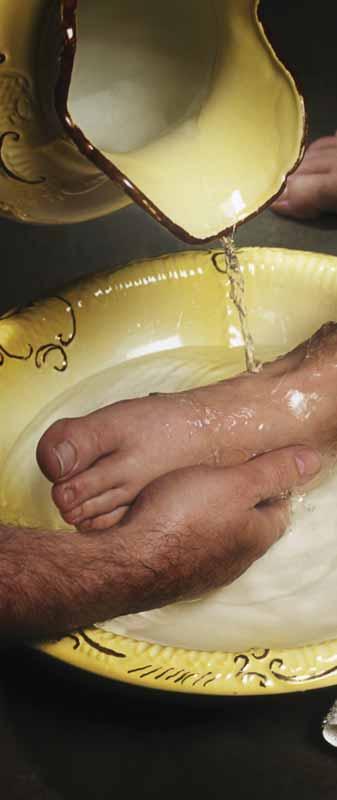
outpouring of God’s love and presence. As we washed the feet of these young leaders and prayed for them, God melted away our cultural differences and fears. We became aware of our common need of God’s grace and love as well as the presence of our leader, Jesus. Trust and friendship were established.
When Jesus gave his disciples the command in John 13:14-17 to wash each other’s feet and follow his example, he promised they would be blessed. In hundreds of foot washing settings over the past 30 years I have experienced that blessing and have been reminded of those words.
Foot washing has been the commissioning service for thousands of MB Mission short term mission participants over the past 25 years as they leave their discipleship training orientations and depart for mission assignments with SOAR, ACTION or TREK programs. Foot washing has also become a regular feature of our International Community of Mennonite Brethren global meetings each year, when some 20 MB conference leaders from around the world gather for equipping, renewal and reporting.
At the recent dedication of the new Hiebert Academic Center on the MB Centenary Bible College campus in Shamshabad, India, we learned that a statue of a person washing another’s feet would become the courtyard centerpiece of the redesigned common area. The MBCBC administration has adopted this symbol of servant leadership as their motto, along with the text, “not to be served, but to serve” (Mark 10:45).
Several days prior to the building dedication, North American and India leaders fanned out into five different regions to hold equipping seminars for Indian pastors and lay leaders. In one location, one Indian leader struggled to have his feet washed by a North American. Although a church planter in South India, his mother had served as a temple prostitute. Was he worthy of being served and honored? Tears flowed as North Americans and Indians washed each other’s feet and embraced each other as one in Jesus, their leader.
While the practice of foot washing has been growing in our mission contexts, is it relevant at the local church level here in North America? What has been our history of foot washing as a Mennonite Brethren family? What are the transferable principles from John 13 that will help us understand the value of foot washing for Christ’s disciples today?
by RANDY FRIESEN AND RAY HARMS-WIEBE
Of the various Reformation groups, the Anabaptists were the only ones who picked up the foot washing practices of the early church. You can consult the Global Anabaptist Mennonite Encyclopedia Online website (www.gameo.org) for a chronicle of foot washing in church history up to the current era.
Early Mennonite Brethren leaders practiced foot washing in their house church meetings as a reminder of the values of humility, equality and servanthood taught by Jesus, and usually connected it to the communion service. Foot washing was treated as a general ordinance of the church in the 1874 copy of the MB Confession of Faith. MB congregations universally practiced foot washing from the 1860s until the 1920s.
When Mennonite Brethren immigrated to the United States, they brought the practice of foot washing with them and according to the GAMEO article, until the 1950s as many as 85 to 90 percent of U.S. MB congregations still practiced it regularly. However, among the later Canadian MB immigrant churches formed in the 1920s, a minority of the churches practiced foot washing. By the time the most recent MB Confession of Faith was drafted in 1999, the practice of foot washing was so limited in MB churches that it was not included in the Confession. It is mentioned as a footnote in Article 6: Nature of the church.
Perhaps the “rediscovery” of the value of foot washing in our current generation has occurred because it is no longer a prescribed and routine practice of the church, but a voluntary and thoughtful choice to apply Christ’s example at the Last Supper in contemporary ways.
The Last Supper has been popularized by paintings that place Jesus in the middle of a long rectangular table. In reality this meal was probably served on a three-sided Roman “triclinium” table, says J.R. Woodward in Creating A Missional Culture. If this is the context for John’s account of the foot washing, which occurred at some point in this Passover meal, people would have sat around the outside of the table and the order of seating would have been very important.
At the Roman triclinium table, the host was usually second from the end on the left side of the table with his best friend to his right and the guest of honor to his left. The rest of the guests were then seated in descending order of importance ending
Perhaps
the “rediscovery” of the value of foot washing in our current generation has occurred because it is no longer a prescribed and routine practice of the church, but a voluntary and thoughtful choice to apply Christ’s example at the Last Supper in contemporary ways.
with the last guest seated across from the host. Some have speculated as to which disciples sat where on that last supper. What we do know is that the disciples often argued as to who was the most important.
Jesus would have been the host, with John seated next to him as his closest friend. When Jesus states that his betrayer is at the table with them, Peter calls across the table to John and asks John to ask Jesus who the betrayer is. Perhaps Peter has taken the last place at the table because he remembers Christ’s statement, “The last shall be first.” Of course he doesn’t feel that he deserves to be seated last. The role of the last person is to wash the feet of others, and we know that hasn’t happened yet. So there is probably some tension in the air that evening.
Jesus identifies his betrayer as the one who dips his bread into the dish with him. Only John on one side or Judas on the other side could reach the bowl. Judas is seated as the guest of honor, to Christ’s left. Interesting.
At some point in the meal Jesus gets up and begins washing his disciples’ feet. This task should have been done when the guests first arrived by the lowest of servants. However, this supper is in a donated room with apparently no servants to greet them. When Jesus comes to Peter, Peter refuses to have his feet washed by Jesus. Interesting. Perhaps Peter feels if he shouldn’t be washing feet, neither should Jesus.
The foot washing that night exposes a lot of positioning and thinking that Jesus wants to confront. Here are three brief take-aways for us today.
John begins his account of that Last Supper by saying that, “Having loved his own who were in the world, he now showed them the full extent of his love” (John 13:1). Foot washing was one of the ways that Jesus communicated his love to his disciples and we also communicate our love to one another.
John goes on to say, “Jesus knew that the Father had put all things under his power, and that he had come from God and was returning to God; so he... wrapped a towel around his waist” (John 13:3-4). Power in Christ’s kingdom is expressed in loving and serving, even our enemies. Foot washing reminds us of that every time we do it.
When Jesus comes to wash Peter’s feet, Peter replies, “No, you shall never wash my feet” (John 13:8). Peter succinctly communicates the pride within all of us related to position, status and honor. Foot washing exposes our pride and gives us an opportunity to receive and share the grace of God with each other.
In a culture where most of us shower or bath daily, foot washing lacks the essential function that it served in Christ’s day. Some have suggested we should be washing each other’s cars or mowing each other’s lawns instead. While that may be true, there is still something very personal and powerful when we simply follow Christ’s example of washing each other’s feet and praying for one another. This could be one of Jesus’ ways of renewing our love for each other today.
Randy Friesen serves as the general director of MB Mission, the global mission agency of the Mennonite Brethren churches of the United States and Canada. Ray Harms-Wiebe is the MB Mission global program team leader.



value Bible reading very much, even if I struggle at times to be consistent. I came to faith later in life and was painfully aware of how little I knew about the Bible. I have grown significantly through my reading over time.
There is so much to know—and not just information about people, places, things and themes. Jesus says to the Jewish leaders in John 5, “You study the Scriptures diligently because you think that in them you have eternal life. These are the very Scriptures that testify about me, yet you refuse to come to me to have life.” The point isn’t Bible knowledge mastery, but to be mastered!
There are lots of helpful ways to read Scripture. Steve Schroeder, pastor at Parkview MB Church in Hillsboro, Kan., introduced me to a method that has helped me solidify my thoughts after reading. The SOAP method can be summarized like this: You choose a Scripture that stands out. You make observations about what’s going on in the text. You write an application of that truth to daily life—being “mastered” by the truth. And lastly, you write a prayer to express what has been revealed. Once that’s done, you go back and add a title to the entry.
Earlier this year I read through the book of Acts using the SOAP method. In this article I share three of the “nuggets” I discovered. My hope is that relating these thoughts will stimulate you to be active not only in Bible reading but also in watching for what God will show you in the process.
Obedience power
SCRIPTURE: “We are witnesses of these things, and so is the Holy Spirit, whom God has given to those who obey him” (Acts 5:32).
OBSERVATION: The apostles appear before the Sanhedrin because Jewish leaders are angry about their public preaching about Jesus and implications of the involvement of Jewish leaders in Jesus’ death.
APPLICATION: The inference that the Holy Spirit is given to those who obey God catches my attention. We often remind people of the indwelling of the Holy Spirit upon believing, and rightfully so. But there is this other crucial aspect of the Holy Spirit within us empowering us to obey. And not just obedience to “be good and not sin” but obedience to live out the mission we’ve been given— to be witnesses and to make disciples.
This reminds me of Acts 1 where Jesus tells the disciples that they will “receive power when the Holy Spirit comes on you; and you will be my witnesses in Jerusalem, and in all Judea and Samaria, and to the ends of the earth.” The Holy Spirit is primarily given for mission. In general, things in the church feel lopsided to me, with a focus more on the Holy Spirit as healer and comforter as opposed to our power for mission.
Is this a cultural thing? Are we using God to “just feel better”? We should reflect and pray on this, asking for Holy Spirit power to do what only the Holy Spirit can ac-
complish through us. And if/as we obey, we will have power to do so—and it will be obvious to everyone that progress in mission will be as a result of his power and not our own.
PRAYER: Heavenly Father, I want to obey. I need your Spirit!
Believing prayers
SCRIPTURE: “’You’re out of your mind,’ they told her. When she kept insisting that it was so, they said, ‘It must be his angel.’ But Peter kept knocking, and when they opened the door and saw him, they were astonished” (Acts. 12:15-16).
OBSERVATION: Herod arrests Peter and intends to put him to death. Many believers gather to pray for Peter. An angel of the Lord miraculously frees Peter from prison and Peter makes his way to the house where they are praying. Rhoda goes to the door where Peter is knocking, recognizes his voice and gets all excited. She leaves Peter outside to go tell the others, who don’t believe her. Mind you, they are praying right now for Peter! What are they praying for?
APPLICATION: Even though the believers are praying about Peter’s imprisonment, plainly they do not believe that he is going to be released. Herod had already killed James the brother of John. Perhaps they are anticipating the same fate and are praying for Peter to be faithful and courageous to the end. It is not “believing prayers” that moves God to free Peter. God has in mind something else that was beyond their understanding.
What I love about this is how absolutely similar I feel in my own prayer life to these gathered believers. God is not hindered by their lack of faith or understanding of what he is doing. In fact, in the end, it is Peter’s captor, Herod, who dies (Acts 12:23). So I need not be discouraged or overly surprised when God answers differently and more gloriously than what I have in mind.
hardships to enter the kingdom of God,’ they said” (Acts 14:22).
OBSERVATION: These are final encouragements to the disciples in cities that Paul and Barnabas visited on that first missionary journey. As a duo they endure a great deal. Up to this point, they have been opposed by a sorcerer, had abuse heaped on them by jealous Jews and were expelled from an area. In the very next town they escape a plot to be stoned by the Jews and in the town after that they have to deal with a massive Gentile confusion that they are actually Greek gods. Eventually some Jews catch Paul, drag him outside the city and leave him for dead.
APPLICATION: Paul’s words to these young churches as he leaves them are wise discipleship. They need to know that “we must go through hardship to enter the kingdom,” in order to persevere through the inevitable challenges that they are going to face. They need to know that having hard lives as followers doesn’t mean something is wrong. It is normal and to be expected.
But there is this other crucial aspect of the Holy Spirit within us empowering us to obey. And not just obedience to “be good and not sin” but obedience to live out the mission we’ve been given.
PRAYER: Heavenly Father, help me to pray in faith and belief in what you can do! You can always do more than I can imagine. You are not limited by my weak faith. Give me faith to believe and courage to follow you in your kingdom work.
Hardship: A key to the kingdom
SCRIPTURE: “Then they returned to Lystra, Iconium and Antioch, strengthening the disciples and encouraging them to remain true to the faith. ‘We must go through many
We need to hear these words too. Perhaps it’s a result of our culture of ease and comfort, but the notion of being a “disciple” and “hardship” don’t seem to go together for us. Too often it seems that we will even avoid decisions that will bring hardship. More and more I sense the need for believers to accept this hard truth.
As we endure what I anticipate will be lots of “kingdom hardship opportunities” in our society, we have an opportunity to suffer well, causing those who observe us to ask about “the reason for the hope that we have” (1Pet. 3:15).
PRAYER: Heavenly Father, enable me to endure hardship for your sake and for the sake of your kingdom.
Stephen Humber, his wife, Mary K., and son, Jacob, live in Omaha, Neb. where Stephen is the discipleship pastor for Stony Brook Church, a USMB church plant.

by DOUG MILEM

Imarried my gorgeous bride at the wise old age of 22 under the impression that I knew exactly what I was getting into. Like many people who vow to love, cherish and honor their partner unconditionally for the rest of their lives, I was head-over-heels in love and thought that was enough to carry us for the next 70 years.
However, the rude awakening that I experienced over the first two years of our marriage forced me to humbly admit that I had no clue what marriage was or what a God-fearing husband looked like. Diving headfirst into the tangled knot we had created that seemed to trap us both in an unhealthy cycle of tension and arguments, I found that we both held misunderstandings about marriage. These misunderstandings led us to hold one another and ourselves to a slew of unfair expectations.
Love is all you need
One of these misunderstandings was that marriage is based solely on love. Sure, love is a critical foundation piece for a marriage. Can you imagine standing in front of all your friends and family, promising to be with your spouse for “better or worse” for the rest of your life without hearts firmly rooted in love? Of course not! However, when two people stand at an altar on their wedding day, do they do more than declare their love?
They declare their commitment. Marriage is a covenant between two people who are laying down their hopes, dreams and desires as they enter into a relation-

ship where the other’s hopes, dreams and desires will also be considered. When two individuals actively lay down their lives for one another, this commitment comes alive. And in a surprising twist, their personal dreams and goals can grow bigger and go further as they are supported by not just one heart, one prayer, one mind or one will—but two.
A second misunderstanding was that I would never have to deal with loneliness once I was married. What I discovered, however, was that some of the loneliest moments of my life occurred while I was married. It is a common issue, and there are many reasons for marital loneliness: communication issues, lack of intimacy, situational stressors, lack of trust, etc.
In my experience, loneliness is rarely the result of being alone. Rather, loneliness is the result of an internal struggle. Personally, I expected my bride to be my rock in times of need. Then I saw the enormous amount of pressure I was piling onto her that she was never built to carry.
As I looked into the mirror, I began to wonder what kind of man and husband God had called me to be. If I fulfilled God’s intentions for me, what kind of wife would my bride be free to become? What would it look like if I became an apprentice of Jesus and loved like he loves and served like he serves?
It would look like me opening up instead of shutting down. It would look like
me finding joy in life instead of focusing on the negative. It would look like eliminating loneliness by finding my identity as a man and as a husband in Christ and learning to love my wife without condition as she blossomed into a woman who was growing in her love and respect for her groom.
The gift of sex
So what about sex? Sex is a foundational element of a marital relationship; it has a vital purpose. No misunderstandings there, right? In coaching couples through this topic, I have found that there are many views on sex in the context of marriage. However, out of all these views, theories and discussions, there is one constant bottom line: sex cannot and should not be an expectation.
Two things tend to happen when sex becomes an expectation. First, sex becomes a focus and a source of stress. It becomes a task that has to be checked off the list rather than an act that a husband and a wife share.
Secondly, at least one partner will begin to feel pressured to fulfill the other’s expectation. This situation can breed loneliness, feelings of guilt for not “living up to one end of the bargain,” etc. Sex should be a gift that a married couple shares with a joyful spirit, stemming from a desire to intimately connect with their spouse.
I have noticed that couples’ sex lives dramatically increase when each person stops holding their spouse to unfair expectations. Communication increases, trust is gained, intimacy becomes safe and love and respect grow. And as a result, couples become more connected physically and emotionally.
“I thought…”
Has your spouse ever said: “I thought after we got married you would grow up,” or “I thought we would communicate better after we got married”? We don’t change our habits and personality just because we get married.
When I asked my wife to marry me, I asked her— not an idea of who I wanted her to be. When she said yes, she agreed to join an imperfect man on this journey we call life. She did not say yes to the man she hoped I might become.
This isn’t to say people shouldn’t ever change. But marriage is not the key that will make change happen. Communication and patience rooted in love and respect are the keys to change. Talk calmly and rationally with your partner about what you need from them. Recognize and appreciate their personality. This is the way to honor your spouse as you communicate your needs.
A happy life
I mentioned that in the first years of marriage I had no idea what it meant to serve my wife as a God-fearing husband. For whatever reason, the tongue-incheek phrase I heard growing up, “A happy wife makes a happy life,” stuck with me. From day one, I operated under the impression that my primary role as a husband was to make my wife as comfortable and happy as I could.
Problems arose when that pressure of being my wife’s foundational source of happiness exhausted me and left me miserable. I was not created to fulfill her every need—that’s what God is for. Working a job, taking care of the house, going the extra mile to communicate with my wife, being empathetic, going to social events that I’d rather avoid and many other things that were positive on their own were all rooted in the wrong place.
I was not running around in circles for the joy of serving or supporting my wife. I was doing all these things in order to make her happy so that my life would be easier. A selfless act done selfishly is no longer selfless. I had to realize that I cannot control her happiness by doing things with or for her. As important as my wife’s happiness is to me, at the end of the day her happiness is her choice. I soon found that as I focused less on making my wife happy and more on simply serving her, I developed a new joy in life and, in turn, our marriage became happier and healthier.
Love and marriage
People aren’t kidding when they say marriage is hard work. But the rewards are incredible. At 22 years old, I never envisioned the challenges and adversity I would face with my wife. I never imagined the woman she would become—a woman who loves Christ more than she loves me. A woman who knows what it means to respect and believe in her husband against all odds because of her faith in Jesus.
I have taken myself by surprise as I continue to grow as a leader of my family and learn how to love radically with Jesus as my guide. And we did this all together. How rudely awakened I have become by this beautiful living covenant called marriage. “And I will betroth you to me forever. I will betroth you to me in righteousness and in justice, in steadfast love and in mercy” (Hosea 2:19).
Doug Milem is a certified life coach and marriage mentor who lives in Phoenix, Ariz., where he is part of Axiom Church, a USMB church plant in Glendale, Ariz. He and his wife, Megan, have been married for five years and are in the process of adopting their first child.



Even the Lone Ranger had Tonto. The fictional, masked hero might be known for riding off into the sunset with a “Hi-yo Silver, away!” after restoring justice to the Old West, but he didn’t do it single-handedly. His faithful companion, Tonto, was always at his side.
When it comes to planting new churches to reach people for Christ, there’s simply no room for working alone, say several current USMB church planters.
“Working together is fundamental for doing mission work,” says Gavin Linderman, church-planting pastor for Axiom Church, Glendale, Ariz. “There’s just no biblical context for doing it another way. We entertain arrogance when we try to do it on our own.”
All too often, it seems, church planters function independently, perhaps because the innovative, risk-taking nature of church planting draws entrepreneurial types who prefer to blaze the trail. Or perhaps because many current church planting approaches place a high value on the personality and leadership of the church planter.
USMB church planting strategies, on the other hand, require a posse—no Lone Rangers allowed. Some USMB church planting partnerships are formal, typically in the form of the project team that leads a church plant during its developmental stages, usually a three-year period of time.
Other times the partnerships form spontaneously outside of district conference lines as local congregations are drawn to a specific need or ministry in another geographic area. These organic relationships, illustrated by the three stories that follow, demonstrate the power of our shared USMB mission: to be congregations that God can use to transform lives.
In the nick of time
For Axiom Church, a church plant in
the Phoenix area, partners arrived at just the right time to help this new congregation weather two early crises.
Last fall, just as Axiom was in an energy-intensive stage of development, medical expenses hit church planter Gavin Linderman and his family hard. Three health emergencies within a few weeks left the family scrambling to meet a $10,000 deductible, which they simply didn’t have.
Quickly—and somewhat mysteriously to Linderman—both prayer support and financial support rolled in until every dollar of that deductible was paid.
For one of those supporters, Hesston (Kan.) MB Church (HMBC), it was all about learning generosity. “We want to be open-handed with the finances God has given us,” says pastor Brad Burkholder, who invited his Southern District congregation to give towards the Linderman’s need as part of the church’s participation in Advent Conspiracy, a national movement intended to encourage worship and generosity during the Christmas season. That means HMBC is more concerned with the Spirit’s leading than with district or even denominational boundaries as they choose where to give, says Burkholder.
Youth from the Southern District Conference (SDC) also showed up at just the right time, donating the offering from their annual Youth Conference to the Lindermans.

“Our heart is to provide opportunities for our Southern District youth to join with God by seeking God in their own lives and experiencing his work all around them,” says Russ Claassen, district youth minister. “This includes helping ‘family’ financially and prayerfully with physical needs.”
A second emergency for Axiom hit when the cost of renovating their new facility turned out to be far more than expected. Again, multiple partners stepped up. One was Valleyview Bible Church, Cimarron, Kan. This small, rural church also in the SDC was dreaming about helping fund a church plant in their district and had raised funds for that purpose. Church leaders saw the impact a gift toward Axiom could have.
Valleyview pastor Darren Rempel says that while it’s unlikely—though not impossible—that Valleyview will plant a church in their backyard, by investing in Axiom, they can still have a church planting impact. “A church plant means there are souls being won,” Rempel says. “It’s exciting to be part of that.”
Valleyview gave a significant amount toward Axiom’s facility needs, and Axiom was able to publicly launch in their facility July 28. Valleyview is working toward refilling their church-planting fund so that they can invest in another church plant—perhaps within their district this time, as they had originally planned.
Linderman says that without such timely support from a larger church family, Axiom might not be a reality now. “This is the way our Lord does things,” Linderman says. “He’s delighted for us to do things together as one.”
When it came time for Mission (Texas) MB Church to name their new daughter church, they chose Iglesia Biblica De La Gracia— Spanish for Grace Bible Church— to honor the sister church
relationship that has grown between the South Texas congregation and Grace Bible Church, Gettysburg, SD. The partnership between the two churches has been key to the birth of this congregation.
On the surface, it seems a strange partnership—an Anglo congregation from rural South Dakota and a Hispanic congregation in the southernmost part of Texas. But God delights in surprises.

It began five years ago when a youth team from the Gettysburg church teamed up with Mission MB Church for SOAR South Texas, a short-term mission organized by MB Mission. In time a sister church relationship grew. As part of their partnership, the Gettysburg church sent teams to Mission each summer to help with vacation Bible school and outreach.
Planting a church wasn’t the intention, but God had other ideas. Lives were changed through a small group and a VBS in an area known as the Seven-Mile Line until it became apparent this could be a church plant. Iglesia Biblica De La Gracia

(IBDLG) has an attendance of about 30, and people continue to come to Christ through this developing congregation. Williams Velez is the pastor.
For Mission MB, the support of the Gettysburg church means expanded financial resources, wisdom for strategic planning and prayer support. Rafael Nunez, pastor of Mission MB, says, “This support to Mission MB Church means a lot to us not only because it is a help we must have, but because it gives us a chance to work together as one body.”
For the Gettysburg church, it’s a chance to be part of reaching a community for Christ in ways they couldn’t have imagined 20 years ago. Back then, the South Dakota church pursued church planting in their remote, rural area, but ran into a dead end. Now, through IBDLG, they see prayers answered, families coming to Christ and the kingdom growing.
“If you will invest in another church, you will see God work in ways you don’t normally see,” says John Langer, a member of the Gettysburg congregation.
A “mixed” lineage
In what may be the ultimate example of unlikely partnerships, a church planting team from Nebraska (in the Central District), is planting a church in Utah (in the Pacific District), with significant support from churches in Oklahoma (in the Southern District).
Jason Quiring, church planter for The Greenhouse, Saratoga Springs, Utah, laughs at the mixed lineage of the church plant. “Isn’t that what the kingdom of God is supposed to look like?” he says.
Jason and Nicole Quiring and Scott and Heidi Goossen and their families moved this summer to this predominately Mormon area just south of Salt Lake City to plant The Greenhouse. They are sent by Henderson (Neb.) MB Church and supported significantly by Fairview (Okla.) MB Church and New Hopedale Mennonite Church, Meno, Okla., among others. It’s a network built and sustained by relationships.
Jason grew up in the Henderson congregation, and both he and Scott were interns at Henderson MB during their
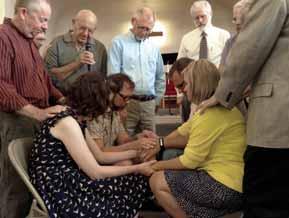
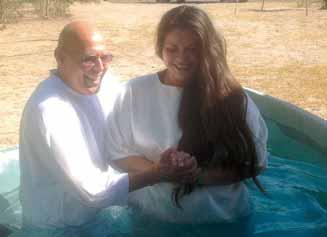
college years, so they had a natural connection to the church. When they began to dream about planting a church in Utah, Henderson MB stepped up.
Church moderator John Quiring says, “God put his opportunity in front of us; how can we not respond?” Henderson MB committed to be a major supporter of The Greenhouse for the first four years, giving over and above their regular district giving to do so.
Connections for The Greenhouse in the Southern District are based on relationships as well. Jason Quiring served as youth pastor at Fairview (Okla.) MB Church, where he worked alongside James Suderman, who now pastors New Hopedale Mennonite Church, Meno, Okla. Because of these connections, both Fairview and New Hopedale have chosen to support The Greenhouse.
The support goes beyond finances. The Henderson congregation has representatives on The Greenhouse project team, communicates regularly and prays fervently. At Fairview, one adult Sunday school class has “adopted” the Quirings as their missionaries. The class prays regularly, provided meals and lodging when the Quirings visited recently and hopes to send a short-term team to assist the project in the future.
Quiring says that within their network, he knows of a 90-year-old and a seven-year-old who have both committed to pray.
That kind of relational support, he says, is every bit as important to the team as the money. “We don’t want to do something on our own,” he says.
These stories are just in the opening scenes, certainly far from finished. But when it’s time for a victorious ride into the sunset, these church planters won’t be riding alone; they’ll have a company of partners and supporters riding alongside. Just imagine what the Lone Ranger could have accomplished if he’d had such support. —Myra Holmes
Skaters and “riders,” with their baggy pants, hairstyles that aren’t especially clean-cut or whole collections of tattoos, aren’t the kind of kids that typically come to church. In fact, they are the kids some church people would rather avoid.
“If you don’t BMX or skate, you would be likely to assume that it’s a rougher crowd,” says Utah youth pastor Josh Jost.
But Jost, youth pastor at the Daybreak campus of South Mountain Community Church in the Salt Lake City, Utah, area, has always had a passion for the riding culture.
“I’ve been riding BMX my whole life,” he says. Because he has been an insider for a long time, he knows that once you get to know these kids, they are kind and friendly— and open to the gospel.
Which is why Jost has teamed up with a few friends and the Daybreak congregation to begin Skate Church, a ministry meant to build relationships among this unique culture.
“We saw that this demographic was very lost and in a very tough place, but also very enjoyable people to hang out with,” says Jost, who is also responsible for weekly Sunday

and Wednesday activities for sixth through 12th graders at the SMCC Daybreak campus.
Jost had dreamed of a ministry to riders for years. When a friend began a ministry to the riding community at his church in Texas, Jost began talking with local friends and with SMCC staff about doing something similar. The feedback he got was encouraging, and Skate Church began in February 2013. The core team also includes David Askvig, Jared McClure and Rob Dean, all Christians who ride and are involved in other area churches. (Askvig and Dean are pictured with Jost on the cover of this issue.)
Skate Church meets the first Tuesday of each month at a local business, We Are One Skate Park. The indoor facility has a shop where riders can buy parts, clothing and supplies as well as space for riders to practice their passion year-round.
That means ramps. Lots and lots of ramps, some designed for specific tricks or skills so riders can “grind,” “air out” and jump to their hearts’ content.
It also provides a natural hangout for those with a common interest. It’s a good place for ministry because this is where many of these kids go every day—it’s the center of


their social life. “You can talk to the kids already there,” Jost says.
Jost says that about 40 percent of the young people who attend Skate Church either walk in or hear about it from a website. He says when they invite a rider who’s just hanging out to attend Skate Church, they never “bait and switch,” but always explain exactly what to expect, including that there will be a Christian message. Riders almost always stay, open and interested.
When Skate Church meets, the first hour is dedicated to riding. Pizza and Gatorade keep riders hydrated and fed. Then the team sets up their stage and sound equipment and spends about half an hour exploring a gospel message. They’ve been using videos from “I Am Second,” which feature testimonies of Christian athletes and have been well received. After prayer, the group plays dodge ball for a different way to interact, then spends more time riding.
One way Skate Church differs from a typical youth group meeting—besides being at a skate park— is the absence of a worship and singing time. For one thing, Jost points out, many of these teens don’t know who God is, so worship wouldn’t have the same context. Plus, they simply aren’t used to singing.
In lieu of formal small group time, discussion of the evening’s lesson happens informally. That informal discussion time is important, because it’s all about relationships. “If we don’t build relationships with these kids, they are not going to care,” Jost says.
He tries to hang out at the skate park other than during Skate Church and encourages kids to get together between times. “My dream is that it will change the skate park culture in the Valley,” he says, hoping that Skate Church attendees will take their passion for Christ into other skate parks and to other riders.
Skate Church is for anyone sixth grade or older who likes to ride BMX, scooters, skateboards or rollerblades. Most of those who come are in middle and high school, but a few are older—in their mid-20s, like Jost. About half also attend Daybreak, and some come from the Draper campus of South Mountain or from other area churches.
Jost estimates that about 80 percent of the kids have a background in The Church of Jesus Christ of Latter-day Saints (LDS) and
have never heard a message of grace. They can have trouble believing that God could love them, especially because those outside their culture view these riders negatively.
“The message that I most want them to hear is that all God wants of them is relationship,” says Jost. “They can just come as they are.”
Feedback from the riders has been positive and encouraging. Some 30 to 40 attend consistently—even one meeting this summer when the temperatures inside the skate park topped 100 degrees.
Jost believes that transformation is happening within many of those who attend, but outward, visible transformation is slow and tough to spot. Patience is one of the biggest challenges of the ministry so far.
He points to some who are now comfortable enough to attend regular Daybreak youth activities or church services. “They trust us,” he says. One young man, already a Christian, consistently offers words of appreciation for an outreach he can bring his friends to. Another has begun to take ownership of the ministry and helps to bring others. Two have committed to baptism—one this summer and one this fall.
Jost and the lead team modeled Skate Church after similar ministries he knew of in Oregon and Texas, so it’s not an unheard-of outreach. But it’s also not common, maybe because it takes just the right “missionary” to understand the riding culture. “Not just anyone could go in there and talk to these kids at the skate park,” Jost says. He continues to ride several times each week, not only because he enjoys it, but also because it gains him respect and credibility: “I’m not just a guy who can’t even do a 180.”
Jost’s hobby has taken on new meaning. “It’s far more than just riding,” says Jost. “It’s hanging out and hopefully one day being able to share the gospel with these kids.”—Myra Holmes






Through the Work for Fun program at Neighborhood Church, Visalia, Calif., children from a lower-income part of the city are rewarded with new opportunities as they serve others.
About seven years ago, Neighborhood established a partnership with a local elementary school, Houston Elementary School. It just so happens that Houston is in a neighborhood that is “always in the news,” according to Stephanie Bartsch, the church’s missional strategist—a part of town plagued by gangs, drugs and poverty. But it’s also an area filled with hardworking families who love their children and want a better future for them.
“It’s one of those neighborhoods that has lots of challenges, but the more we’ve gotten involved, the more we’ve fallen in love with these kids and these families that are working really hard to love their children and provide for their families,” Bartsch says.
Neighborhood Church has organized a number of outreach efforts with Houston, such as a shoe giveaway, backpack giveaway and a lunch buddies program. But as volunteers interacted with the Houston families, they began to realize that these parents and families wanted to give back, not just receive.
Bartsch says that while giveaways are well-intentioned and do meet a need, too often they have unintended negative consequences: Parents might feel humiliated because they can’t provide, kids learn they don’t have anything valuable to contribute and both can expect to receive without effort.
So Neighborhood Church launched Work for Fun in the 2012-2013 school year with a focus on relationships and on dignity. The program is pretty much what it sounds like: Kids in third through sixth grade meet at Houston School one Saturday each month to work on a service project and earn a fun reward. The new program is adapted from similar programs designed for adults.
Service projects are kid-appropriate but also aim to make a real difference. For past service projects, participants made teddy bears for kids in need, wrote notes of appreciation for teachers, planted trees to create a park-like area behind the school and painted artwork to decorate the local rescue mission.

Bartsch says the kids serve willingly. “I think they love the service more than the fun stuff,” she says. As they serve, they learn that they can make a positive impact on someone else’s life.
Kids who serve earn “fun dollars” toward activities that will help “expand their worldview and their possibilities,” says Bartsch—such as a picnic, a field trip to the zoo or an educational nature hike.
About 125 kids participated in Work for Fun last school year; Bartsch expects similar participation this year.
In addition, parents and older siblings of the kids are invited to participate as volunteers, and a parent group at the school helps with planning. Bartsch says the parents enjoy being involved and trusted with leadership and have a deep sense of ownership in the program.
About 30 Neighborhood volunteers make it happen each time, often bringing their own children to serve alongside the Houston children. As families work together, relationships form, even across language barriers.
Bartsch says that volunteers don’t overtly preach at Work for Fun, but “the gospel is part of everything we do…. They know we’re from Neighborhood Church, and they know we do this because we believe that God loves them deeply and we love them.”
To see a video from last year’s Work for Fun program, visit: http://youtu.be/P2SlKQPUsXY. —Myra Holmes






Don Morris Mission USA director
If you have ever driven about Kinshasa, DR Congo, you know that the traffic is so bizarre, congested and dangerous that you frequently see your life flash before your eyes. I was there in August with my son and his wife who adopted a little girl from DR Congo. I went with them as they met her and began the in-country process of getting her to America. It was an interesting experience to say the least.
Papa John—the Congolese Cowboy—was our driver during the time we were there. He’s the only Congolese I saw wearing a cowboy hat, and I still have Johnny Cash songs running through my mind as John played them over and over again as we drove around Kinshasa. At age 64, Papa John has seen a lot of hardship.
John was born in the volatile eastern part of Congo, moved as a young man to Kinshasa to find work and then raised a family there. Now he drives adopting American couples to the places they need to be as they process all the governmental requirements for adoption. John speaks 17 languages. He’s a good man.
I asked John about churches in Kinshasa, and he angrily described them as places where pastors are the ones with the nice cars and homes as they skimmed money from the churches’ coffers. His intensely negative view of the church was disconcerting. As we talked further, I asked him if there were any good churches, and he acknowledged that there were a few.
As I probed further, John indicated that he is a believer in Jesus, that Jesus is his Savior and that he
For all the technological advances in the past decade, the desire for human connectedness remains.



knows he is a sinner in need of forgiveness—but that he has stopped going to church. With that testimony, I encouraged John to find a church that wasn’t corrupt and to then begin enhancing his walk with Jesus. I mentioned that we have many Mennonite Brethren churches in Kinshasa that would welcome him. We talked about this quite a lot, and he indicated before we left that he was convicted to get back to church and to pursue Jesus more fully.
I was struck with the uniformity of the vast need people all over the world have for a relationship with Jesus. Here was a 64-year-old Congolese cowboy who realized he needed to go deeper with Jesus and that he did need the church to help him. I see people all over our nation who need the exact same thing. They need a good, solid church to help them with their own following of Jesus. Mission USA is striving to plant more of these kinds of churches every year.
Ten years ago, slightly over one out of 10 Americans self-identified as LONELY. Today that number has doubleda paradoxical reality in the full swing of the social media age.
Source: Barna Group 2013
It was a spiritually charged and lively atmosphere with many people in attendance when Axiom Church, Peoria, Ariz., the daughter church of Copper Hills Community Church in Glendale, Ariz., held their official launch July 28.
In early July the church completed renovation of a storefront site in this rapidly growing city in the Phoenix metro area. Several Mennonite Brethren donors and churches assisted with the cost of renovation. The main meeting area has a capacity for about 175 people and for an additional 25 children in the separate children’s area. Attendance following the launch has been in the 80s.
“To be such a young church and have had the opportunity to publicly launch a new facility for our city has been a huge testament of what God is preparing us for long term,” writes pastor Gavin Linderman. “We have been blessed with the support of our national and local family and God is responding.”
Axiom Church is focusing heavily on discipleship, helping people grow in their relationship with Jesus.
“Just this last week one of our new—actually we’re all new—members of Axiom Church reached out to a friend and invited him into our community,” says Linderman. “Through some discussions, prayer and the proclamation of God’s Word, we witnessed this young
man say, ‘It’s time for me to put my flag in the ground for Jesus.’ This really excites us as now we get to help see him through to maturity.”
Linderman says, “We really believe God has asked us to make our decisions in faith and to stretch ourselves, and that’s what we have done and will continue to do. God is faithful in abundance and that’s exciting. There are a handful of ‘unlikelies’ hanging around right now that we believe will come to know Jesus and hopefully call Axiom Church their community and home.”
Axiom is founded on the core principles of the necessity of connected small groups, overall missional focus and healthy, meaningful Sunday gatherings. Although a few “older” people have also attended, the majority of the Axiom congregation are young singles and couples with many small children. The good number of children requires a solid children’s program that is currently being led by volunteers.
“This is all so exciting!” says Megan Milem, worship leader. “God has truly blessed us. I think he will use Axiom as a place for people to find genuine hope and help.”
Linderman says, “These are still very early days with many challenges and opportunities. We know God will be faithful to help us.” —Mission USA


RJ Thesman

It happens every time. As soon as I turn away from my mother’s door in assisted living and walk down the hallway— away from her—the emotions hit me. You’d think I would be used to them by now.
For 10 years my family struggled with Dad’s dementia and all the accompanying emotions. Now that Mom has been diagnosed with Alzheimer’s, I should expect the same feelings.
But still, the emotions grip my soul, and I cry all the way to the car, then sit in the driver’s seat until my vision is no longer blurry.
When we become caregivers, certain emotions come to live with us. One of these emotions is sadness. The long goodbye, aka Alzheimer’s, triggers a sadness unlike any other grief I have suffered. It is not the unexpected grief of a sudden loss—a miscarriage, unemployment or illness—but rather the day-by-day grief steps caused by the regressive nature of the disease. Even though Mom remembers me today, she will someday forget how to introduce me to her friends in assisted living. Sad, but true.
Another sadness lies ahead. If Mom does not graduate to heaven within the next few years, we will have to relocate her to the nursing home section of the facility.
“Never put me in a nursing home.” I can still hear the echo of her plea.
Sadness reinforces the truth that at the end of this particular journey, my siblings and I will be orphans. Grief will multiply.
Another emotion, rejection, surfaces every time Mom forgets a memory that is important to me. “Remember when?” is no longer a game we play. And when Mom does hesitate with my name, rejection swallows logic.
I know she doesn’t mean to reject me. Somewhere, cached in her soul is my baby
face, her firstborn. But I miss our shopping trips and the way we used to talk about the books we were reading. I no longer hear her laughter, because she can’t comprehend jokes anymore. When I send her cards and she shows them to me, clearly imprinted with my signature, then tells me they are from someone else—I feel rejected.
Although sadness and rejection bring pain, guilt is the emotion that tortures me.
No, Mom, we never wanted to put you into assisted living, but you couldn’t live alone anymore, and all of us work long hours. No one else can take care of you. I’m sorry and I hate it. I feel guilty.
When I hug her goodbye and tell her I have to go back to Kansas, she can’t understand why I’m leaving. Reality screams that my work is a state away, and my life cannot make room for my mother. I am the long-distance caregiver in the family, demoted by miles and the work I cannot do anywhere else. Guilty again.
Even while writing this, I feel guilty that my emotions are front and center when Mom deals bravely with fear, rejection and sadness.
It helps to journal about these caregiving emotions, include them in my next book or vent with a friend. The emotions of caregiving are now my reality, and I know they affect me deeply because they are foreshadowed by love. If I didn’t love my mother so much, I wouldn’t care.
And because I love her, I’m sad that she can’t be who she used to be.
As the author of The Unraveling of Reverend G, RJ Thesman writes about Alzheimer’s, dementia and how to find hope when life unravels. She is an author, editor and certified Christian Lifecoach. Her website is: www.rjthesman.net.

Sybil Kolbert
When I started my blog, “Peace it All Together,” (peaceitalltogether.blogspot.com) 18 months ago I had no idea what I was doing. I only knew that I wanted to write and to share my stories of family and faith and the struggles and blessings that come along with them.
I first felt God speaking to me about starting a blog after spending a period of time in prayer and fasting during Lent in 2012. My desire to hear God increased as I got into blogging, and I felt God’s nudging in a more intense way than I ever had before. What had changed? Had God decided that he was ready to communicate with me? Honestly, I think he was always ready. It was me who wasn’t.
As time passed and I received more comments from friends and blog readers about how my words and posts encouraged others, I gradually came to realize that being able to transparently share my heart through writing offered me the amazing ability to connect with others.
As a result, I have become more intentional about sharing my faith, recognizing that God intends for me to be a person of influence for him. At first, I was uncomfortable and lacked confidence in this role. But God continues to equip me for his plan.
For me, sharing Jesus through social media is similar to sharing Jesus in any other venue. In order to effectively influence others for God, I must grow in the knowledge of God and follow the path he has set for me. So, how does one do that? I have found the following to be helpful:
Stop. Life is crazy. Busy. Intense. Or maybe that’s just for me. If I don’t stop once in a while—if I just
keep going through the days without thinking of anything except the next item on my to do list—I will miss the opportunity to impact people in a positive way. It is similar to going weeks without talking to a friend, without even realizing it. Influence requires stillness.
Look. Once you’ve stopped, the next task is looking. Search your surroundings and your contacts for someone who needs something. Maybe it’s a meal, a kind word or a note on their dashboard. If you take the time to really look, you will see the need. It will be evident.
Listen and obey. Even when we stop and identify a need, we don’t often listen to that still, small voice that is nudging us. In order to influence we have to act. We have to be in tune with that voice from God and follow it. It is only because I began listening and obeying his voice that I have been able to encourage and support others, even when I don’t feel worthy or capable of doing it.
The bottom line is that we are all influential in one way or another. But being a person of influence for Christ is not only about what we do, it is about being ready and open to what God wants to do through us. We can just let it happen or we can be intentional about it.
I am confident that I am doing the job that God has planned for me, which he has prepared me for and led me to. I feel honored and blessed to be used.
Sybil Kolbert is a school psychologist by profession and uses her blog, “Peace it All Together,” to reflect on the circumstances of life, faith and issues related to having a child with sensory needs. Visit her at http://peaceitalltogether.blogspot.com.

Looking for a resource on financing a college education? Take a look at a new video series prepared by and for college students to guide fellow Christian students through the financial challenges of college. The short videos are produced by Everence, an insurance and financial services ministry of Mennonite Church USA and other churches, and feature students from the visual and communication arts department at Eastern Mennonite University, Harrisonburg, Va. See the videos at www.Everence.com/college.


In the August/September issue Jason Quiring was listed as being received as a member of Henderson (Neb.) MB Church. He was not; he performed the baptism and led the service. Jen and Carol Myers were the members received.
Kaleb Neher, Jordan Schaeffer, Sarah Schaeffer, Kaelin Maier, Sarah Cooley, Kelli Buxton, Cari Smith, Annie Zachman, Konner Buxton, Will Martin and Addison Smith were baptized Aug. 25 at North Oak Community Church, Hays, Kan
Braden Vix and Angela Vix were baptized July 28 at Bible Fellowship Church, Minot, ND.
Donna Coleman, Nolan Coleman, Brooke Ellis, Shahn Ellis, Carolyn Prodnuk, Tanya Smith, Kenny Nelson, Hunter Holland, Samantha Tewell, Kylie Dennison, Adam Thomson, Tyler Hadsock, Erika Cunningham, Lindsay Jensen, Barry Houghtalen and Matthew Tulin were baptized Aug. 11 at South Mountain Community Church, Draper, Utah. Debra VanWyngaarden, Case VanWyngaarden, Ryan Pullman, Sarah Shaw, Antonio Henriquez, Hunter Callahan, Ian Ewell, Joy and Paul Baltazar and Kristy Hernandez were baptized Aug. 11 at the Daybreak campus.
Joshua Miller was baptized July 28 and received as a member of Zoar MB Church, Inman, Kan Stephanie Thiessen was also received as a member.
Kurt and Lauren Willems were received as associate members of College Community Church MB, Clovis, Calif., July 14.
Rusty and Marla Thomas and Matthew Heinrichs were baptized and received as members of Fairview (Okla.) MB Church March 31. Jessica Eitzen was received as a member.
North Oak Community Church, Hays, Kan., honored Ken and Rachel Ediger for 25 years of ministry Aug. 17-18.
Kyle Goings has resigned as youth pastor at Bible Fellowship Church, Rapid City, SD. The church held a farewell service for him and his wife, Katie, Sept. 15. Jon and Michele Fiester have assumed the youth leader responsibilities.
Gaylord Goertzen, who is retiring from full-time ministry after serving USMB congregations for 34 years, was honored by Ebenfeld MB Church, Hillsboro, Kan., with a community reception
Sept. 24 and a catered dinner and celebration program following the Sept. 29 worship service. Garden Park Church, Denver, Colo., has called Kalen Heller to work half-time as visitation pastor.
Ken and Janet Cartlidge are serving as interim pastoral couple at Grace Bible Church, Gettysburg, SD
Dan and Bonnie Keegan are serving as interim pastoral couple at Community Bible Church, Mountain Lake, Minn
Troy Weiland is the new pastor at Christ Community Church, Sioux Falls, SD. An installation service for him and his wife, Racheal, was planned for Sept. 15. David and Kathy Glader had been serving as interim pastoral couple.
Wilmer Thiessen was installed Sept. 8 as parttime pastor of visitation at Parkview MB Church, Hillsboro, Kan.
Katie Bair served as a summer intern at Harvey (ND) MB Church.
Tom Voth concluded his ministry as pastor of caregiving at First MB Church, Wichita, Kan., at the end of August. Ben Marquez ended his ministry as youth pastor at the end of July. Kruze Sanders is serving as interim director of youth ministry. Susan Perkins is the new part-time children’s ministry event coordinator.
Ben Geddert served as a summer intern at College Community Church MB, Clovis, Calif
Bob Plett retired as minister of music at North Fresno (Calif.) MB Church at the end of May. Milton Friesen began as minister of music Aug. 1.
Marissa Hiett served as a summer intern at Fairview (Okla.) MB Church
Ethan Nikkel served as a summer intern at Pine Acres MB Church, Weatherford, Okla
Lindsay Quick served as an intern in the areas of children’s ministry and outreach this spring at Lighthouse Community Church, Wichita, Kan
Amick, Jake Lonnie, Shafter, Calif., member of Shafter MB Church, April 27, 1936—July 19, 2013. Parents: Jake and Belle Amick. Spouse: Shirley Amick. Children: David, William, Kathleen Wallace; five grandchildren; two greatgrandchildren.
Balzer, Ella Mae, Inman, Kan., member of Zoar MB, Inman, Spouse: Albert. Children: Diane Weber, John, Elaine Fallon; six grandchildren. Brown, Donna (Bartel), Fairview, Okla., member of Fairview MB Church, Jan. 26, 1936—June 4, 2013. Parents: Henry E. and Elizabeth (Young)
Some 80 teens from the churches of the Latin American MB District (LAMB) attended a district youth camp July 11-13 in Weslaco, Texas. The theme of “Camp 180” was based on 2 Cor. 5:17 and reflects a desire for youth to “walk in a different direction and follow Christ,” says Oziel De La Cruz, youth pastor at Grace Point @ Grulla, La Grulla, Texas.
Camp activities included morning and evening sessions, small groups and team games. The Grace Point worship team led the morning worship times and local musicians, Lenette Castaneda Band, led the evening worship. Keynote speakers Iris Castaneda, a youth director from Palmview, Texas, and Chali Martinez, lead pastor of a church in McAllen, Texas, spoke about God’s love, challenged teens to never give up and talked about five names given to early Christians because of their changed lives. Small group sessions helped teens grapple with reallife issues such as music, social media, dating and prayer.
De La Cruz says that the district intends to make this an annual summer event. The eight churches of LAMB are located in South Texas, and most are Spanish-language congregations.



Volunteers from Heritage Bible Church, Bakersfield, Calif., recently assembled 150 “Blessing Bags,” designed to be kept in the car and given to those asking for help on the street corners. Each bag contained practical items such as bottled water, lip balm, tissues, socks and information about resources. Those who have distributed the bags report that recipients are usually grateful, especially for the water and socks. Bakersfield has one of the highest homeless populations in the state.
Bethesda Church, Huron, SD, hosted a unique summer outreach in response to the changing face of their community. “Super Summer Jam” for elementaryaged children was held at four sites July 23-26 with a concluding carnival July 27 at the city park. “Our community has changed significantly in the last several years with different cultures and skin tones coming to Huron,” says Pastor Anthony Lind. “Our goal was to share the gospel with the all the children of our town, not just those who look like us.” Sites were chosen in each of the city’s four quadrants to keep the events within walking distance. Activities were duplicated at each site and included lunch, songs, Bible lessons, games, crafts and special entertainment. Read more at www.usmb.org/huron-outreachevent.

Bartel. Spouse: Roy Brown. Children: Pamela Toews; one grandchild.
Dowers, Shirley A. (Reddick), Enid, Okla., member of Fairview (Okla.) MB Church, Sept. 24, 1932—March 8, 2013. Parents: Fred E. and Vila (Porter) Reddick. Spouses: Merle Eldred; Ivan Dowers, deceased. Children: Patti Reidhead, Vicki Seward, Amy Turner, Bruce Eldred, Keith Dowers; nine grandchildren; two great-grandchildren.
Enns, Selma Tiessen, Buhler, Kan., member of Buhler MB Church, April 13, 1929—June 24, 2013. Parents: Henry and Susanna Tiessen. Spouse: Harry O. Enns, deceased. Children: Brenda Brennan, James, Phil; six grandchildren.
Faul, John C., Hillsboro, Kan., of Hillsboro MB Church, June 8, 1931—Aug. 10, 2013. Parents: Charlie F. and Caroline (Seibel) Faul. Spouse: Eloise Franz. Children: Annette Funk, Ellynne Wiebe; five grandchildren.
Heinrichs, Marvin L., Reedley, Calif., member of Dinuba (Calif.) MB Church, Aug. 27, 1923—Jan. 27, 2013. Parents: Jacob J. and Sara (Thiessen) Heinrichs. Spouse: Alma Thesman, deceased. Children: Jerry, Barbara Hofer, Rollin, Lyndon; 11 grandchildren; 15 great-grandchildren.
Hofer, Richard E., Dinuba, Calif., member of Dinuba MB Church, March 13, 1942—July 19, 2013. Parents: Egon and Naomi Hofer. Spouse: Betsy Fry. Children: Janelle Hammond, Katie Jenan; four grandchildren.
Kusch, Erna Lee (Chamberlain), Fairview, Okla., member of Fairview MB Church, June 27, 1920— Mar. 17, 2013. Parents: Ernest and Eva Chamberlain. Spouse: Clarence E. Kusch. Children: Jeanne Sproul, Penny Payne, Sue Bredel; three grandchildren.
Kusch, Mary “Wilma,” Fairview, Okla., member of Fairview MB Church, Feb. 10, 1918—Aug. 9, 2013. Parents: Henry K. and Mary Marie (McDermed) Howard. Spouse: Kenneth C. Kusch, deceased. Children: Shannon DeYoung; two grandchildren.
Janzen, Eugene, Fairview, Okla., member of Fairview MB Church, Nov. 21, 1930—April 20, 2013. Parents: Arthur and Sarah Janzen. Spouse: Lillian (Wichert) Janzen. Children: Lynette Lucas, Susan Morris, Steven, Ann Yarrow, Lois Enomoto; 12 grandchildren; two great-grandchildren.
Martens, Elda, Fairview, Okla., of Fairview MB Church, Nov. 17, 1931—July 15, 2013. Parents: Henry and Emma (Friesen) Wiebe. Spouse: Henry Martens. Children: John, Paul, Joyce; five grandchildren; six great-grandchildren. Miranda, Frank Murrieta, Kingsburg, Calif., of Dinuba (Calif.) MB Church, March 24, 1956—July
21, 2013. Parents: Frank and Gloria Miranda. Spouse: Rosie. Children: Mathew, Thomas, Frankie, Nicholas; two grandchildren.
Schroeder, Lavina Louise Prieb, Buhler, Kan., member of Buhler MB Church, April 4, 1918— Aug. 1, 2013. Parents: John J. and Kathrenia (Jantzen) Prieb. Spouse: Menno G. Schroeder, deceased. Children: Dale, Jerry, Harold, Rodney, Roger, Jolene Snyder; 21 grandchildren; 36 great-grandchildren.
Unrau, Arthur, Hillsboro, Kan., of Hillsboro MB Church, Feb. 15, 1912—June 1, 2013. Parents: David H. and Anna (Becker) Unrau. Spouse: Isabelle Claassen, deceased. Children: Phyllis Schroeder, Elvera Rempel, Priscilla Wieneke, Paul; five grandchildren; 10 great-grandchildren.
Vix, Arthur, Minot, ND, of Bible Fellowship Church, Minot, April 26, 1921—June 30, 2013. Parents: Emanuel and Martha (Seibel) Vix. Spouse: Emma Marzoff. Children: Kathy Holdeman, Robert, Rolly; seven grandchildren; eight great-grandchildren.
Valleyview Bible Church, Cimarron, Kan., provides backpacks filled with books, crayons, toys and activities to help keep children engaged during the worship service.
Mountain View Community Church, Fresno, Calif., offered a four-week course on “Spiritual Parenting of Teens” July 30-Aug. 20. The course included a light dinner and encouragement from a panel of veteran parents from the church.
Attendees of Kingsburg (Calif.) MB Church focused on prayer during the month of August. Weekly prayer guides were offered, and various homes were specified as places to pray each weeknight.
Kids third through eighth grade learned from local artists, practiced their creativity, and hosted a showcase as part of Summer Arts Camp Aug. 5-8 at South Mountain Community Church, Draper, Utah
Enid (Okla.) MB Church offered a seminar on teaching the gospel to children Aug. 23-24.
The Bridge Bible Church, Bakersfield, Calif., has added an evening men’s Bible study to their men’s ministry.
Russian Evangelical Church, Shakopee, Minn., recently purchased a large campground in
Northern Minnesota to enhance their local ministries. They also hope to make it available for other Central District groups.
Hillsboro (Kan.) MB Church will host a community women’s conference Nov. 1-2, featuring Kathy Troccoli, a well-known speaker, songwriter and author. Men 18 and older at Grace Community Church, Sanger, Calif., are invited to the “Man Cave” on Wednesday evenings for a different activity each week, such as Cave Bash (food and fellowship), Cave Talk (men’s issues), Cave Challenge (BBQ and games), Cave Word (Bible study) and Cave Help (service project).
A series of family movie nights this summer at HeritageBible Church, Bakersfield, Calif., featured installments of “The Bible,” previously featured on The History Channel. Popcorn sales benefited the women’s ministry.
The first annual “Family Pie Fest” at Lincoln Glen Church, San Jose, Calif., Aug. 2 included a pie eating contest, pie poetry, pie toss and a “soggy pie walk.”
July 7 and 21 were “Bike to Church” Sundays at Trailhead Church, Centennial, Colo. Participants donated money toward a Mennonite Central Committee project in Serbia.
Children in grades one through six from Shafter (Calif.) MB Church met July 28 at Iglesia Companerismo Cristiano, Shafter, for a pizza lunch and service project: making placemats for Meals on Wheels.
More than 150 volunteers from First MB Church, Wichita, Kan., put in 1,208 hours of work in June and July to help clean up after a tornado struck the city.
Volunteers from The Heart Church, Tulsa, Okla., cooked and served some 1,500 hot dogs for the local elementary school’s “Meet the Teacher” night and community fair Aug. 15.
Kingwood Bible Church, Salem, Ore., hosted a week of neighborhood events July 14-20, including
LOCAL CHURCH JOB OPENINGS
Youth Pastor: First MB Church, Wichita, Kan., is a thriving church pushing 1,000 in our worship attendance, with a strong emphasis on reaching those who have yet to cross the line of faith and equipping believers for greater impact. We have one traditional and two contemporary worship services. Our staff is unified and pumped for where God is going to take us with our next phase of growth. This individual is responsible for leading our junior high coordinator and youth ministry team in visioning, planning and implementing a comprehensive ministry for junior high, high school and college age ministries. For more information, visit www.firstmbchurch.org
Lead Pastor: Henderson (Neb) MB Church is a congregation of 107 members in a rural community looking for a pastor with leadership skills; strong values of prayer, personal integrity
and professional growth; who relates well with young adults and families; has a relevant preaching style and heart for evangelism. For further information: email mbchurch@mainstaycomm.net or visit our website hendersonmbchurch.com
Senior Pastor: Grace Bible Church, Gettysburg, SD, is searching for a full-time pastor with leadership qualities, who can relate well with young married/single adults. Our evangelical church is very social and out-going with approximately 110 members. Send resumes and inquiries to Ray VanBockel c/o Grace Bible Church, 310 South Broadway, Gettysburg, SD 57442.
Vacation Rental: Near Glacier National Park in Kalispell, Mont. Mountain setting. Two bedrooms, kitchen and bath. mtgetaway@centurytel.net or 406-755-3920.
vacation Bible school, a food bank, garage sale and a free BBQ, concert and car show.
Volunteers from Koerner Heights Church, Newton, Kan., offered free oil changes Aug. 3 to widows, single moms and others who might not be able to afford an oil change. Snacks and childcare were available to those waiting. A cookout and free movie was offered that evening.
Shorelife Community Church, Capitola, Calif., was again an official sponsor for the annual Wharf to Wharf Race July 28, donating 15,000 water bottles printed with the church logo and John 7:37: “Let anyone who is thirsty come to me and drink.”
Good News Fellowship, Ferndale, Wash., entered a float in a community parade July 27. The theme for the float was “Way Out West,” which was also the theme for the church’s vacation Bible school Aug. 5-9.
North Park Community Church, Eugene, Ore., participated in Project Hope, a cooperative effort to serve schools, by working in the schools Aug. 16 and sharing school essentials with needy kids Aug. 17.
Statement of ownership, management and circulation
Statement of ownership, management and circulation
Publication title: Christian Leader. Publication number: 0009-5419. Filing date:09/06/13. Issue frequency: bimonthly. Number of issues published annually: 6. Annual subscription price: $10. Complete mailing address of known office of publication: 107 N. Main, Box 155, Hillsboro, KS 67063. Complete mailing address of headquarters or general business office of publisher: same. Full names and complete mailing address of publisher, editor and managing editor: Publisher: U.S. Conference of MB Churches, 7348 W 21st Suite 115, Wichita, KS 67205; Editor: Connie Faber, 107 N. Main, Box 155, Hillsboro, KS 67063. Managing editor: none. Owner: U.S. Conference of MB Churches, 7348 W 21st Suite 115, Wichita, KS 67205. Known bondholders, mortgagees and other security holders owning or holding 1%or more of total amount of bonds, mortgages or other securities: none. Tax status has not changed during proceeding 12 months. Issue date for circulation data: Oct/Nov 2013. Extent and nature of circulation: the first number represents the average number of copies of each issue during the proceeding 12 months, the number in parentheses is the number of copies of a single issue (Aug/Sept. 2013) published nearest the filing date. (a)
Total number of copies: 9,265 (9,118) (b) Paid/requested circulation: 1) paid/requested outside county mail subscriptions: 8,267 (8,126) 2) Paid in-county subscriptions: 560 (557) 3) Sales through dealers and carriers, street vendors, counter sales and other non-USPS paid distribution: 0 (0) 4) Other classes mailed through the USPS: 275 (271) (c)
Total paid and/or requested circulation: 9,102 (8,954) (d) Free or nominal rate distribution: 1) Free or nominal rate outside county copies 0 (0) 2) Free or nominal rate incounty copies (0) 0 3) free or nominal rate copies mailed at other classes through the UPPS 13 (14) 4) free or nominal rate distribution outside the mail 0 (0) (e) Total free or nominal rate distribution outside the mail: 13 (14) (f) Total distribution: 9,115 (8,968) (g) Copies not distributed: 150 (150) (h) Total: 9,265 (9,118) (i)Percent paid and/or requested circulation: 99.85% (99.84%). I certify that all information furnished is true and complete. I understand that anyone who furnishes false or misleading information on this form or who omits material or information requested on the form may be subject to criminal sanctions and/or civil sanctions. Signed: Connie Faber












































